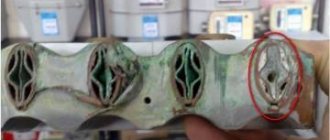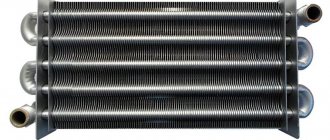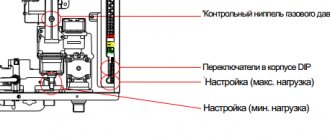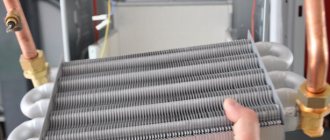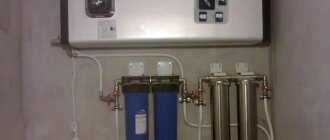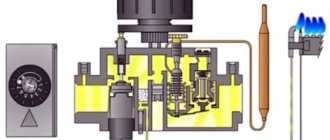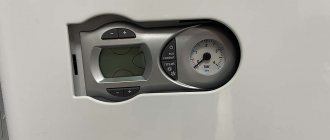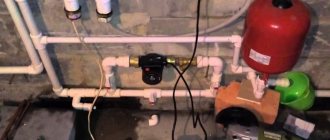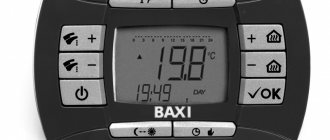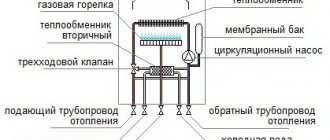The use of even relatively clean water as a heating fluid leads to clogging over time, not to mention untreated, contaminated coolant. The boiler heat exchanger is the first to suffer from clogging and scale. Precipitation on its walls narrows the cross-section of the pipe and the thermal conductivity of the metal, which affects not only the heating system, but also the operation of the boiler, which has to operate at increased power levels.
In the article we will look at how internal and external cleaning of the heat exchanger of a gas boiler is carried out. The process is not particularly difficult and can be done independently, without the involvement of specialists.
About the dangers of scale in a heat exchanger
Heating of tap water for a hot water supply system (DHW) in a double-circuit gas boiler or in a gas water heater is carried out in a flow-through heat exchanger.
It is known that when heated above 54 oC, crystallization of salts of chemical elements dissolved in water, mainly calcium and magnesium, occurs. Solid salt crystals settle on the heating surfaces of the heat exchanger and form a strong crust on them.
In addition to hardness salts, scale deposits include other solid particles found in water. For example, rust particles, oxides of other metals, sand, silt, etc.
The amount of salt in water determines the degree of its hardness. There are hard water, which contains a lot of salt, and soft water, with a small amount of salt.
If the source of tap water is a river or other natural body of water, then the hardness of such water is usually low. You are lucky, the water in your home is soft.
Tap water from a well usually contains more hardness salts. And the deeper the well, the more salt there is in the water.
A hard crust of hardness salts, rust, sand, silt on the heating surface of the heat exchanger prevents the transfer of heat through its metal walls. In addition, deposits reduce the clearance of the heat exchanger channels. As a result, the heating temperature and hot water pressure gradually decrease, and the walls of the heat exchanger overheat , which reduces its service life.
The internal structure of a double-circuit gas boiler using the example of Protherm Gepard 23 MTV and Panther 25.30 KTV (Panther). The secondary DHW heat exchanger is located in the lower compartment.
Double-circuit gas boilers most often have two heat exchangers. One is primary , in which water is heated with gas for heating. The other is a secondary DHW heat exchanger , in which heating water from the primary heat exchanger heats water from the domestic hot water supply.
There are also double-circuit boilers in which both water for heating and water for domestic hot water are heated with gas in one combined bithermic heat exchanger. A bithermic heat exchanger accumulates scale faster, and it is more difficult to clean it from scale.
The geyser has one DHW heat exchanger , in which tap water is immediately heated by gas.
Regular descaling is necessary only for the DHW heat exchanger , in which there is a constant accumulation of deposits of hardness salts.
In the channels of heat exchangers with heating water, scale accumulation occurs only when fresh water is replaced or added to the system. This happens quite rarely and in small volumes.
If there is a filter at the entrance to the heating water boiler, then other dirt from the heating system does not enter the boiler and there may be no need to clean the boiler coolant channels during its entire service life. It is not necessary to descale the primary heat exchanger at the same intervals as the DHW heat exchanger. However, “servicemen”, without proper reason, often insist on descaling the primary heat exchanger, at the same time, just in case. Naturally, they charge for this.
Secondary plate heat exchanger for hot water supply of a double-circuit gas boiler. Two holes serve to circulate heating water through the heat exchanger. Through the other two, cold water enters and heated hot water exits. Regular descaling of the inside is required.
Bithermic heat exchanger of a double-circuit gas boiler. On the right are pipes for heating water. On the left are the DHW water connections. Regular cleaning of scale inside and soot outside is required.
Heat exchanger for DHW gas water heater. Regular cleaning of scale inside and soot outside is required.
How often to descale the heat exchanger
Equipment manufacturers require maintenance of a gas boiler or geyser to be carried out annually .
I recommend cleaning the heat exchanger from scale at every equipment maintenance, that is, annually.
Some "owners" do not approach the equipment until something happens. But, as a rule, it “happens” at the most inopportune moment. The severity of the damage and the cost of repairs are higher. Some defects, outwardly invisible, lead to an increase in gas consumption over a long period of time.
Read: How to reduce the high gas consumption of a boiler for heating a house.
In the Russian Federation, there are “Rules for the use of gas in terms of ensuring safety during the use and maintenance of in-house and intra-apartment equipment when providing public gas supply services”, approved by Decree of the Government of the Russian Federation No. 410 of May 14, 2013.
In accordance with current rules, in order to ensure the safety of gas-using equipment, household consumers must enter into a maintenance agreement with a specialized organization.
In December 2016, the Code of the Russian Federation on Administrative Offenses was supplemented with Article 9.23, which provides for punishment in the form of a fine of up to 30 thousand rubles for individuals for violating the rules for ensuring the safe use and maintenance of indoor and indoor gas equipment.
Fines are provided for:
- avoidance of concluding a mandatory contract for the maintenance and repair of gas equipment in homes;
- refusal to admit a representative of the organization to perform maintenance; avoidance of concluding an agreement on the performance of work on diagnosing gas equipment;
- avoidance of replacing gas equipment; actions that led to an accident or an immediate threat of harm to human life and health;
- untimely or poor-quality performance of work on maintenance and repair of in-house or in-apartment gas equipment.
I do not recommend home craftsmen to carry out work on the gas duct of the boiler or heater. If necessary, a home mechanic can do some simple work that is recommended to be performed when servicing the boiler.
Read: Gas boiler maintenance
The bithermic heat exchanger of a gas boiler, as well as the heat exchanger of a gas water heater, must be regularly cleaned not only of scale inside, but also of soot deposits outside.
A home craftsman can easily clean the DHW heat exchanger of scale inside and soot outside with his own hands.
Depending on the degree of hardness of tap water, the amount of water used and its heating temperature, the heat exchanger must be cleaned of scale at intervals of 1 - 5 years.
Manufacturers of heat exchangers use various methods that hinder and slow down scale deposits on its walls. For example, they increase the speed of water flow, create a turbulent regime of fluid movement in the heat exchanger, and protect the surfaces of the heat exchanger channels with anti-corrosion coatings and polish them. All these measures, to one degree or another, create a self-cleaning effect, which slows down the process of scale accumulation. But there are no heat exchangers for household gas boilers and water heaters that are completely self-cleaning of scale and never require descaling.
I advise you to do this work annually, in the summer. You should not wait several years until the heat exchanger is covered with a thick layer of scale inside and overgrown with soot on the outside.
You will have to pay for a thick layer of scale and soot with increased gas consumption and reduced equipment durability. In addition, a thin layer of dirt can be removed much easier.
Do-it-yourself cleaning from soot and soot
Soot and soot make it difficult for heating equipment to operate. There are models that automatically turn off in such cases. If this does not happen, then combustion products may enter the room. Harmful gases can poison the residents of the house, so it is important to clean boilers on time to prevent such situations.
Heat exchanger cleaning agent
Work order:
- Prepare the tools: brushes, screwdrivers, open-end wrenches (most often wrenches size 8-17 are suitable), needle, brush, rags. If you plan to completely clean the channels at the same time, you will also need a means for flushing the gas boiler heat exchanger.
- Turn off the gas, remove the front wall of the boiler, disconnect the wires, ignition electrode, burner tube. During cleaning, it is advisable to immediately replace the pilot burner gasket
- Next, you should get the burner and swirlers. They and the surface of the heat exchanger are cleaned with brushes - soft and for metal. The inside of the channels is blown out using a vacuum cleaner.
- It is convenient to clean the burner with a brush and a needle smaller than the diameter of the burner hole.
Boiler design diagram
Advice. Do not try to widen the burner hole with a thicker needle. It will be easier to clean next time, but the performance of the heating equipment may deteriorate.
DIY booster
- When cleaning and washing the heat exchangers of gas boilers with your own hands is completed, the equipment is reassembled in the reverse order. First, install the burner, nozzle, tube, connect the ignition electrode, etc.
- The assembled boiler is tested. It is turned on and the connections of the tubes and burners are checked for tightness. If the equipment operates normally, it can be put into operation. If there are any malfunctions, the boiler will need to be disassembled again and the connections sealed.
Replacing the heat exchanger in a gas boiler with your own hands
Methods for descaling a heat exchanger
Cleaning heat exchangers from scale is carried out by treating deposits with special liquid compounds that dissolve salt, release and wash out rust, sand and other insoluble particles.
For a double-circuit gas boiler (boiler), two fundamental methods are used to descale the DHW heat exchanger:
- With removal and dismantling of the heat exchanger from the boiler, column.
- Without removing the heat exchanger from the boiler or gas water heater.
At the second stage, the method of influencing the cleaning liquid on deposits is selected.
Important! The chemical reaction of scale salts with acid produces carbon dioxide. Gas can collect in the heat exchanger channels into large bubbles, which will displace the liquid and prevent the cleaning solution from interacting with the scale.
For this reason, the flood cleaning method is only suitable for plate heat exchangers removed from the boiler. From the straight channels of the plate heat exchanger, located with the holes up, the gas easily escapes out. Plate-type secondary heat exchangers for hot water supply of double-circuit gas boilers are usually used.
To descale heat exchangers whose channels have a curved shape, it is necessary to use forced circulation of the solution. To do this, the heat exchanger is connected to a pumping unit, which will force the cleaning solution to circulate in the heat exchanger channels. The heat exchangers of geysers and bithermal heat exchangers of double-circuit gas boilers have a curvilinear shape of the channels.
This method requires connecting special equipment to the boiler (heat exchanger), which includes pumps, solution containers, filters, hoses, and connecting fittings. Circulation promotes the constant removal of gas bubbles from the solution, more intensive dissolution and washing out of contaminants.
This method is usually used by enterprises and organizations that provide services to the public.
The best cleaning quality can be obtained if you order the work from specialists.
You can remove the heat exchanger from the boiler yourself and take it to a boiler repair service to remove scale. This service will cost less than calling a technician to your home. And the quality of cleaning using professional equipment will be higher.
Products for construction and repair
⇆
Home cleaning is more suitable for plate heat exchangers removed from the boiler, which have not yet boiled too much. It is beneficial not to delay cleaning.
How to remove a heat exchanger from a gas boiler, column
For all brands of boilers and gas hot water heaters, the heat exchanger is removed in different ways. But this procedure usually does not present any particular difficulties. No special tool is required. But it will be better to find instructions, a website, pictures or videos on the Internet on this topic. For the first time, you can invite a service specialist and watch how he removes the heat exchanger.
An example for a double-circuit gas boiler Protherm Gepard 23 MTV and Panther 25.30 KTV (Panther).
To remove the secondary DHW heat exchanger, you need to unscrew two screws - shown by red arrows and remove both mounting rails (at the bottom of the figure).
DHW hot water flow (flow)
sensor An example for a double-circuit gas boiler Protherm Gepard and Panther. The body of the plate heat exchanger is pressed to the base by mounting rails. After the tires are removed, pull the heat exchanger up and remove it.
Before removing the heat exchanger, it is necessary to empty the boiler of water. To do this, close the taps at the entrance to the boiler of the heating pipes (direct and return). Close the tap at the cold water inlet and disconnect the cold water tube from the boiler. Water will drain from the boiler through the open cold water pipe. Open the hot water taps to completely empty the DHW tract of water. Open the drain valve on the boiler, on the right under the pump, to drain the heating water.
When reinstalling, check that the heat exchanger is positioned correctly - the markings on its side wall should face forward.
1 — mounting rails, heat exchanger holders; 2 — holder screw; 3 - gasket; 4 - heating water filter at the inlet to the heat exchanger; 5 - DHW heat exchanger of a gas boiler;
Clean the filter in the heat exchanger inlet pipe on the left, closer to the rear wall. 1 - gasket; 2 - filter;
Before installing the heat exchanger in place, do not forget to clean the filter, item 2, which is located in the inlet pipe of the heat exchanger on the side of the heating circuit (on the left, closer to the rear wall).
It is recommended to change the gaskets between the heat exchanger and the base, item 1, each time during installation. DHW heat exchanger gasket, rubber ring: 22.2x13.5x5 mm. There is a circular recess on the inside. Article number: 0020014166 (10 pieces).
How to remove the secondary DHW heat exchanger of a Baxi Eco gas boiler
Removing the secondary DHW heat exchanger of a BAXI Eco gas boiler
The plate DHW heat exchanger of a BAXI Eco boiler can be easily removed using a screwdriver as follows:
- Close the taps at the boiler inlet of heating water and cold water.
- Drain heating water only from the boiler through the drain valve.
- Drain the water from the DHW system.
- Unscrew the two screws (directly in front of you) securing the DHW heat exchanger and remove it (see figure).
The BAXI Eco boiler is equipped with a cold water filter. To clean the filter, proceed as follows:
- Turn off the tap at the cold water inlet to the boiler.
- Drain the water from the DHW system.
- Unscrew the nut on the water flow sensor block (see figure).
- Remove the water flow sensor unit along with the filter.
- Remove dirt.
In BAXI Eco boilers, I also recommend cleaning the NTC temperature sensor of the DHW system and its location from limescale.
Types of pollution
In most cases, plaque is:
- calcium carbonate;
- fatty and organic sediments;
- deposits of iron oxide and salts;
- limestone.
It is formed during the circulation of liquid with impurities, which regularly accumulate on the internal walls of heat exchange equipment. Without flushing, the thickness of the sediment constantly increases, impedes the movement of the working medium, interferes with the normal operation of the apparatus and reduces its efficiency.
Plates for the heat exchanger before and after washing Source maksom.ru
Washing a collapsible plate heat exchanger is possible chemically and mechanically. The first method does not require disassembling the equipment and is more popular. Mechanical cleaning options are used only in cases of severe contamination; they require dismantling the heat exchanger and require large amounts of time and labor.
How to remove scale from a heat exchanger
To descale at home, I recommend using a 20% citric acid solution (250 g/liter) as a cleaning liquid.
You can also use commercially available special compounds to descale household washing machines and dishwashers. Read the contents of the packaging carefully. The chemical should be designed to remove scale deposits , not to soften water (not to prevent deposits).
Less accessible, but if desired, you can find and buy special compositions (liquid or powder) for professional cleaning of boiler heat exchangers from scale. The selection of such chemicals should be done with caution. There is a wide range of strong chemicals available for cleaning different types of equipment. You can buy a chemical that will corrode the metal or protective coating of the heat exchanger.
Particular care should be taken when choosing a product for cleaning the heat exchanger without removing it from the boiler. The selected chemical composition should not damage not only the metal of the heat exchanger, but also boiler parts made of other metals, as well as parts made of rubber and plastic.
In order not to make a mistake in the choice, I recommend that the home craftsman use a relatively chemically weak and therefore safe, time-tested, accessible and cheap chemical - food-grade or industrial citric acid (250 g/liter).
If deposits do not accumulate, then to regularly clean the heat exchanger from scale, you can even use conventional toilet treatment products containing acid, for example, oxalic acid.
Removing scale by pouring a cleaning solution into the heat exchanger
Watch the video that shows how to remove and descale the secondary plate heat exchanger of a DHW gas boiler "Ariston".
Here, to remove scale, a cleaning solution is poured into both cavities of the heat exchanger. To increase the efficiency of the process, it is recommended to place the heat exchanger filled with liquid in a container in a water bath and maintain it at a temperature above 60 °C for at least 1 hour. Then the heat exchanger cavities are washed under a strong stream of water from the tap.
This simple method is recommended for removing thin deposits.
To fill all the cavities of the secondary DHW heat exchanger of a wall-mounted gas boiler, approximately 0.25 liters of cleaning solution will be required.
The chemical reaction of scale salts with acid produces carbon dioxide. Therefore, the release of gas bubbles can be observed from the openings of the heat exchanger.
If the gas evolution stops, then the chemical reaction has stopped. This can happen in two cases, either there are no more scale salts in the heat exchanger, or there is not enough acid to continue the reaction with the scale remaining there. The acid concentration in the solution gradually decreases as it reacts with scale salts.
If there are doubts about completely descaling the heat exchanger, I recommend rinsing the heat exchanger with a strong stream of water and pouring a new fresh portion of acid solution into it. Repeat the entire cleaning process. If you see that gas bubbles have reappeared, then you didn’t do it in vain.
Forced circulation of the solution in the heat exchanger removed from the boiler
And from the following video you will learn how to remove a bithermic heat exchanger using the Nova Florida boiler as an example.
In this option, the heat exchanger removed from the boiler is connected to a pumping unit, with the help of which the cleaning solution is forced to circulate through the heat exchanger channels. The bithermal heat exchanger has a complex channel configuration.
During the cleaning process, it is recommended to change the direction of movement of the solution in the heat exchanger.
This cleaning method allows you to quickly and efficiently remove significant scale deposits from a heat exchanger with a curved channel shape.
Stages of mechanical flushing
Directly flushing the heating system in a private house or apartment is a long and labor-intensive procedure:
- The coolant is removed from the system. If this is a house, then there are no problems, but for high-rise buildings you will need access to the basement, which is often closed. Before calling a specialist, you need to take care of this in advance.
- The pipes are disconnected from the radiators. Sometimes you just can’t remove them; you need to heat the coupling with a cutter.
- When the radiator is removed, you need to visually assess its condition, since to speed up the work, mechanical cleaning may first be required.
- The battery is turned upside down and the hole at the bottom is closed. Water is poured into the device right up to the “neck” and drained using the bottom hole. The liquid should flow out, taking with it all the dirt. The process must be repeated until the water comes out clear.
Mechanical flushing is best done outdoors Source gidroguru.com
It is necessary to rotate the radiator because the coolant, moving through it, leaves scale-like growths, and by pouring the liquid in the opposite direction, the surface is cleaned more effectively. If there is a lot of dirt and this option is ineffective, it is necessary to use special acidic agents.
Attention! These acids must not be used for aluminum radiators.
Descaling without removing the heat exchanger from the boiler or column
The following video shows how to assemble a simple device from available materials for cleaning the heat exchanger without removing it from the boiler.
I would like to draw your attention to the following:
- You can take any of the available pumps, including those from used equipment.
- Be sure to install a filter at the pump inlet or after the pump, at the water supply to the boiler. Otherwise, dirt from the container with the solution will go back into the boiler and clog the filter and flow sensor in the boiler.
- It is better to heat the solution to 60 degrees. To do this, you can even turn on the boiler for a short time to heat the hot water supply.
In this option, you should not change the direction of movement of the cleaning solution. It must coincide with the direction of water movement during boiler operation.
You should be more careful when choosing the composition and concentration of the solution to remove scale. Solutions can have a destructive effect on other parts of the boiler, including those made of various metals, plastic and rubber.
Which is the best anti-scale filter for the column? - question in the comments
Manufacturers of geysers prescribe that if the water hardness is above 20º F (where 1º F = 10 mg CaCO3 per 1 liter of water), then you must install a polyphosphate dispenser (filter) or a similar system for softening the water.
When choosing, I recommend reading the technical data sheet of the device. The technical data sheet must indicate in numerical format and with units of measurement the effectiveness of reducing water hardness after the filter. If there are only general words about the purpose, without numbers, then this is a deception.
For example, there are devices on sale that are called something like this - electromagnetic scale converters. In the official document, in the technical data sheet of the device, there is no indicator of a decrease in water hardness after the device. Or another performance indicator that can be verified. The manufacturer does not promise or guarantee anything specific to the buyer. And this is no coincidence!
More articles on this topic:
⇒ How to reduce the high gas consumption of a boiler for heating a house ⇒ Setting up, adjusting the power of a gas boiler ⇒ Malfunctions and error codes of a gas boiler Ariston, Protherm, Baxi ⇒ Either cold or hot water comes from the boiler ⇒ Setting the pressure in a heating system with a membrane expansion tank
More articles on this topic
- Reinforcement of masonry walls made of aerated concrete and gas silicate blocks
- Canopy, canopy for external door
- External three-layer stone wall with brick cladding
- Technology for insulating facades and exterior walls of a house with do-it-yourself mineral wool
- Correct wooden house made of construction timber
- Facade paint for exterior use
- Home mini sauna in the bathroom of an apartment or house
- Bituminous shingles. Installation and laying of soft roofing
We service the igniter and water intake unit
If there is a need to clean the water unit, do not rush to disassemble the entire device. Take a look at the operating instructions for the water heater, find the “frog” in the diagram and follow the following algorithm:
- Remove the adjuster knobs and front cover.
- Dismantle the water unit by disconnecting the pipes.
- Unscrew the screws holding the cover, remove it and get to the membrane.
- Clean the filter - mesh and water holes in the frog body using a wooden stick or soft copper wire. Remove scale with a brush.
- Rinse the parts with water and assemble the assembly. Replace damaged or cracked membrane immediately.
Clean the pilot burner jet (wick) with thin copper wire or a toothpick moistened with alcohol. Wipe the ignition electrodes and the flask of the flame sensor (thermocouple) thoroughly from soot, otherwise over time the column will begin to turn off spontaneously.
